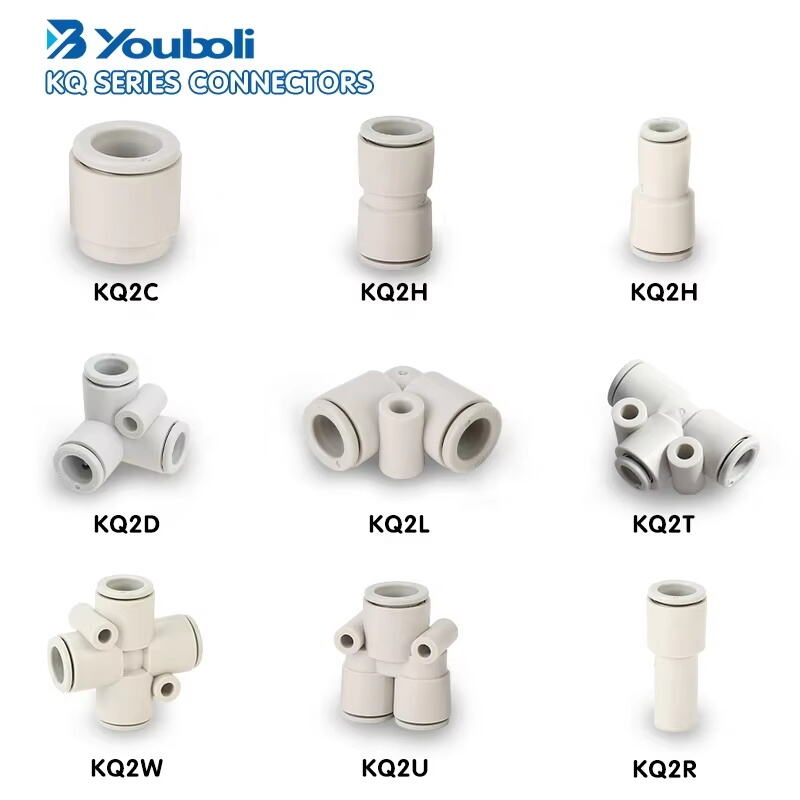Introduction: How Pneumatic Connector Advancements are Driving Automation in Industries
Pneumatic connector technology plays a significant role in industrial automation by enhancing operational efficiency and fostering innovations in manufacturing industries. These connectors serve as vital components that facilitate seamless assembly lines, improve energy efficiency, and reduce operational downtimes. Recent advancements in pneumatic connectors have particularly impacted sectors like automotive and pharmaceuticals, where precision and reliability are paramount. Staying updated with these trends is crucial for businesses aiming to remain competitive in advanced manufacturing, as these innovations continually drive productivity and open new avenues for process enhancements.
New Materials for Enhanced Durability: Advanced Polymers and Metals Improving Connector Lifespan and Performance
The integration of advanced polymers and metals in pneumatic connectors is revolutionizing their durability and performance. These materials, renowned for their resistance to corrosion and wear, significantly enhance the durability of connectors. The adoption of these advanced materials ensures pneumatic systems endure the tough environments typical in industrial applications. For instance, stainless steel and specialized polymers are widely used due to their exceptional resistance to harsh chemicals and physical wear.
Moreover, these materials enable connectors to perform under extreme conditions, such as exposure to high temperatures or corrosive substances. Their ability to withstand such conditions extends the lifespan of the connectors, ensuring reliability and reduced need for replacements. A study in the Journal of Fluid Power highlighted how these materials have improved performance metrics, with some connectors achieving a lifespan increase of up to 30% due to these enhancements.
Leading experts in pneumatic connector technology emphasize the indispensable role of these materials. They note that not only do these materials provide longevity, but they also contribute to consistent performance under demanding circumstances, ultimately contributing to lower operational costs and increased uptime. As the industry continues to innovate, staying informed about these materials' capabilities provides a competitive edge in optimizing pneumatic systems for maximum efficiency.
Smart Connectors for IoT Integration: Pneumatic Connectors with Built-in Sensors and Connectivity for Real-time Monitoring
Smart connectors are revolutionizing the Internet of Things (IoT) landscape by enabling pneumatic systems to have real-time monitoring capabilities. These connectors facilitate seamless communication within IoT ecosystems, ensuring data flows uninterrupted, thereby optimizing the entire system's efficiency. For industries leveraging pneumatic technology, this integration translates into operational transparency and enhanced flexibility in system management.
Built-in sensors within these smart connectors enhance performance by providing critical data that allow for predictive maintenance. This approach helps in identifying potential issues before they lead to system failures, consequently reducing downtime and maintenance costs. For instance, the continuous monitoring of pressure levels by these sensors can trigger alerts well ahead of mechanical failures, enabling timely maintenance interventions.
Industries adopting these smart connectors witness notable improvements in operational efficiency and cost savings. A leading automotive manufacturer successfully integrated smart pneumatic systems with IoT capabilities, resulting in a significant reduction in assembly line halts and operational costs. By utilizing real-time data, the company streamlined its production process and improved overall equipment efficiency, underscoring the transformative potential of smart connector technology in modern industrial settings.
Higher Pressure and Temperature Tolerance: New designs capable of handling extreme industrial environments
Advancements in design technology have significantly improved the performance of pneumatic connectors under higher pressure and temperature conditions. These innovations include the use of advanced materials like stainless steel and specialized polymers, enhancing the durability and performance of pneumatic components. These materials enable connectors to reliably withstand extreme environments without compromising their functionality. This improvement is pivotal for industries such as oil & gas and aerospace, where equipment is regularly subjected to harsh conditions.
The implications of these capabilities are far-reaching for industries that operate in extreme environments. In the oil & gas sector, for instance, pneumatic connectors with enhanced tolerance ensure the safety and efficiency of operations, where any failure could lead to catastrophic results. Similarly, in aerospace, these connectors help maintain the integrity of systems that must perform under mounting pressure and varying temperatures. These capabilities not only boost operational efficiency but also play a crucial role in ensuring safety and reliability.
Industry reports underscore the growing demand for connectors with higher tolerance levels. According to recent statistics, there is a projected increase in the market size for pneumatic components, driven by the need for reliable solutions in high-pressure and high-temperature applications. This rise highlights the essential role that technological advancements in connector design play in meeting the evolving needs of modern industries, ensuring safety and reliability where it matters most.
Quick-Connect Features for Increased Efficiency: Tools for rapid, leak-free connections reducing downtime.
Quick-connect features in pneumatic connectors significantly contribute to faster setup and maintenance times in industrial applications. Designed to streamline the installation process, these connectors enable workers to make secure, leak-proof connections swiftly and without specialized tools. This ease of use not only speeds up operations but also simplifies maintenance routines, making it easier to manage complex systems with minimal disruption.
The impact of quick-connect features on reducing downtime and minimizing leak-related issues is profound. In industries where time is of the essence, such as manufacturing and automotive, these connectors save vital minutes during assembly processes and repairs by eliminating the time-consuming tasks traditionally associated with securing fittings. As a result, they enhance overall efficiency and productivity by ensuring systems operate smoothly and without costly leak-induced stoppages.
Substantive evidence from industry professionals and case studies highlights the tangible benefits of quick-connect technology. Many users report significant time savings and improved productivity within their operations. For example, in one case study, a manufacturing plant reduced its assembly line downtime by 30% after switching to quick-connect pneumatic systems, demonstrating the practical advantages of these features in real-world industrial settings. This case underscores the importance of quick-connectors in ensuring operational efficiency and reliability.
Sustainability in Pneumatic Connector Design: Eco-friendly Materials and Energy-saving Technologies
Sustainability in pneumatic connector design is gaining unprecedented attention, with a focus on using eco-friendly materials. These materials are not only pivotal in reducing environmental impact but also offer enhanced durability and performance. For instance, biodegradable polymers and recycled metals are becoming increasingly common in connector manufacturing, providing a sustainable option without sacrificing quality. Such materials ensure that companies can maintain operational efficiency while meeting environmental regulations.
In addition to eco-friendly materials, modern pneumatic connectors incorporate energy-saving technologies that contribute to significant carbon footprint reductions. Advanced designs often feature lower pressure drops and minimized leakages, leading to energy conservation. Such innovations not only help in achieving compliance with stringent environmental standards but also result in lower operational costs. According to industry insights, the integration of these technologies is expected to drive future developments in pneumatic connectors, steering the industry towards more sustainable practices. As these trends gain momentum, the connector market will likely see a significant shift towards greener solutions, fostering broader adoption of sustainable practices across various sectors.
FAQ
What are pneumatic connectors?
Pneumatic connectors are components used in machinery to connect different elements of pneumatic systems, aiding in the transfer of energy through pressurized air or gas.
How do smart connectors enhance IoT integration?
Smart connectors provide real-time monitoring through built-in sensors, facilitating seamless communication within IoT ecosystems. This helps in predictive maintenance and operational efficiencies.
Why are advanced materials important in pneumatic connectors?
Advanced materials like specialized polymers and stainless steel enhance the durability and performance of connectors, allowing them to withstand extreme conditions and increasing their lifespan.
Are there eco-friendly options for pneumatic connectors?
Yes, options like biodegradable polymers and recycled metals offer eco-friendly solutions. These materials reduce environmental impact while maintaining efficiency and performance.
Table of Contents
- Introduction: How Pneumatic Connector Advancements are Driving Automation in Industries
- New Materials for Enhanced Durability: Advanced Polymers and Metals Improving Connector Lifespan and Performance
- Smart Connectors for IoT Integration: Pneumatic Connectors with Built-in Sensors and Connectivity for Real-time Monitoring
- Higher Pressure and Temperature Tolerance: New designs capable of handling extreme industrial environments
- Quick-Connect Features for Increased Efficiency: Tools for rapid, leak-free connections reducing downtime.
- Sustainability in Pneumatic Connector Design: Eco-friendly Materials and Energy-saving Technologies
- FAQ

